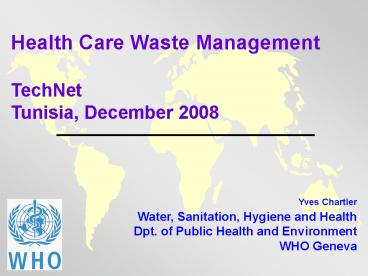Cholera prevention and control - PowerPoint PPT Presentation
1 / 28
Title: Cholera prevention and control
1
Health Care Waste Management TechNet Tunisia,
December 2008 Yves Chartier Water,
Sanitation, Hygiene and Health Dpt. of Public
Health and Environment WHO Geneva
2
Are we concerned?
3
WHO is at Risk?
4
Where Are we?
5
Yves C
6
(No Transcript)
7
(No Transcript)
8
(No Transcript)
9
(No Transcript)
10
Support provided as today
- 72 GAVI countries
- 7 Global Environmental Health countries
- In Steps
- National Steering Committee and Working Group
(ministries, - potential donors, partners, civil society)
- National assessment leading to recommendations
(RAT CAT) - Definition of national plans, regulatory
framework - mobilization of resources
- Implementation leading to success stories or
lesson learned for - replication in other settings and countries
11
Resource mobilization
- A financial
- WHO Core Principles
- GAVI country applications
- Global funds
- Donors
- Foundations such as Gates and Melinda foundation
12
Resource mobilization
- Safe health care waste management has a cost
13
Resource mobilization
- B players in the HCWM world
- WHO country office sometimes overloaded
- Partners and necessary networking
- Consultants / Experts
- Academics / Research
- Ministries low level staff, recognition,
capacity building.
14
Support provided - Suppliers
- Technology inventory done by Health Care Without
Harm at - http//www.noharm.org/details.cfm?ID1514typedoc
ument - or www.noharm.org.
- WHO Health Care Waste Web Site
- http//www.healthcarewaste.org/en/technicals.html?
search
15
Recent developments on-going research
- 1 - Waste Disposal Unit
IT Power India
Head OfficePuducherryNo. 6 8, Romain
Rolland Street, Puducherry - 605 001, INDIATel
91-413-234 2488 / 222 7811 Fax 91-413-233
2776 / 234 0723
http//www.itpi.co.in/Contact_IT_Power/Contact_IT_
Power_India.htm
16
Recent developments on-going research
- 2 Global Environment Facility Hospital in
Tanzania
17
Recent developments on-going research
- 3 Govt of AP and PATHs work in Andhra Pradesh
18
Recent developments on-going research
- 4 Sharp Blaster
A dry-heat, low-temperature needle
decontamination unit, the Sharpsblaster
decontaminates needles by heating them to 160-200
degrees C for 100-150 minutes. Measuring
35x50x48cm the device is small enough to be
portable and can sit on a table. Its processing
capacity means it has application in areas
generating moderate quantities of solid clinical
waste.
19
Recent developments on-going research
- 5 Needle Remover and safety
20
Recent developments on-going research
- 6 - Recycling
21
Challenge Pneumococcal vaccine
- Paper
- Glass
- Rubber
- Plastic
Yves C
22
MANAGEMENT OF WASTE FROM INJECTION ACTIVITIES
1. DISPOSAL OF THE WHOLE SYRINGE
2. SEPARATION OF NEEDLES AND PLASTIC SYRINGES
2a. Disposal of Needles
2b. Disposal of Plastic Syringes
Several countries are currently managing
needles and syringes according to this procedure.
However, pilot projects are being carried out to
allow a validation from WHO regarding the ease of
use and safety of needles removers which may
carry a risk of needle stick injuries.
23
Reseach and tool for Implementation
- Planned for the coming months a study on safe
health care waste management and its - Cost effectiveness
- Health impact
- Environmental impact (if feasible)
- Monitoring tool
24
To build and promote capacity building
- Indira Gandhi National Open University distance
learning - programme
- WHO Teacher's Guide
- Current update of Safe Management of wastes
- from Health Care Activities
25
Yves C
26
WHO / HCWM Web Site http//www.healthcarewaste.or
g/en/115_overview.html
- HCWM (11 pages covering intro, news, basic
info, risks, risk - reduction, waste steps, categories,
emergencies, agreement, - spillages, policy)
- Search tools
- 144 documents on health care waste
- 29 links to organizations web sites
- Country information
- 4 country case studies
- 61 technical systems
- Lexicon
- Management
- Training
- Regulatory
- Technologies
- Costing
- Contacts
27
Think positive! This is a real challenge, maybe
one of the most complex in health care, but we
can feel changes and progresses in managing waste
28
Thank you!
Yves C































